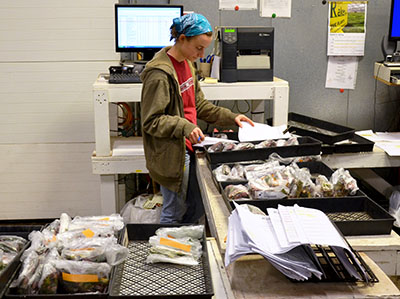Which vegetative cuttings should I stick first?
Species are generally categorized high, moderate or low based on their sticking priority.

Greenhouse growers are now receiving unrooted cuttings from suppliers as the spring season begins to ramp up. What are the best management practices when receiving unrooted cuttings? How do growers evaluate their quality and determine which ones should be stuck first?
Upon arrival of cuttings, boxes should be opened immediately and inspected for wilting and quality, including appropriate length, caliper, leaf number and size. Also inspect for proper labeling and quantity, and noticeable signs of damage, stress, disease or death. Determine the cutting-tissue temperature with an infrared thermometer. Cuttings should be removed from the box to cool as quickly as possible, especially if the temperature of the cuttings is greater than 68 degrees Fahrenheit (20 degrees Celsius) or if the box has been in transit for more than two days.
According to Michigan State University Extension and Purdue University Extension, species are generally categorized high, moderate or low based on their sticking priority. This categorization is based primarily on their sensitivity to ethylene or temperature extremes during shipping, difficulty for root initiation, susceptibility to desiccation and stock plant nutrition. The condition and tissue temperature of the cuttings upon arrival and the species sticking priority will affect the potential storage longevity as well as their performance in propagation. Growers should use this information along with the availability of labor, propagation and cooler space to determine which of the three established handling protocols are followed.

Growers should immediately open boxes of incoming cuttings to inspect their temperature and quality. Photo by Roberto Lopez, Purdue University
High-priority species are immediately stuck into the rooting media within four hours of arrival:
- Agastache
- Bacopa
- Coleus
- Crossandra
- Dahlia
- Geranium
- Heliotrope
- Hybrid euphorbia
- Lantana
- Lavender
- Portulaca
- Sweet potato
- Thunbergia
- Wallflower

Is growing the high-priority “fussy” plants worth it? This gorgeous thunbergia was featured on Michigan’s Garden Plant Tour. Photo by Heidi Wollaeger, MSU Extension
Moderate-priority species should be stuck within 24 hours of arrival:
- Fuchsia
- Licorice plant
- Impatiens
- Lithodora
- Mandevilla
- Garden phlox
- Poinsettia
- Strawflower
- Yarrow
Lower-priority species should be propagated within 48 hours of arrival. When cuttings are not or cannot be stuck upon arrival, they should be unboxed and placed on shelves in a cooler at a high relative humidity, e.g., 80 to 95 percent. For cold-tolerant species, such as geranium and petunia, the temperature set point in the cooler should be between 41 to 50 F (5-10 C). Chilling-sensitive species, such as impatiens and poinsettias, should be placed at 50 to 59 F (10-15 C).
For more detailed information on increasing the rooting success of cuttings, check out our recent e-GRO alert, “Increasing the Rooting Success of Challenge Vegetative Cutting Species.”
Growers will also find these short e-GRO videos useful for managing their propagation environment:
- Watering Plugs and Bedding Plants – Growers will learn how to manage moisture of young plants (from stage 1 to stage 4), by Kimberly Williams, Kansas State University.
- Measuring Air, Plant, and Substrate Temperature with Sensors – Growers will learn to measure media and vegetative cutting temperatures, by W. Garrett Owen and Roberto Lopez, Purdue University.
- Measuring Light Intensity in the Greenhouse – Growers will learn to measure light in the greenhouse, by Roberto Lopez and W. Garrett Owen, Purdue University.



 Print
Print Email
Email




